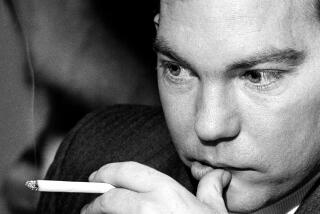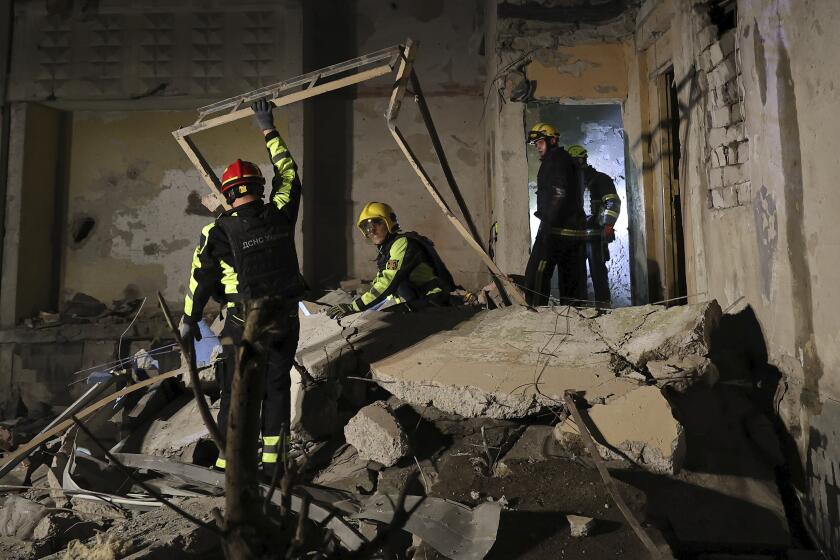Combat follows soldiers home
They nicknamed themselves the Lethal Warriors, and during two tours in Iraq, the soldiers of the Army’s 2nd Battalion, 12th Infantry regiment confronted some of the war’s cruelest fighting, hunting insurgents through the warrens of Baghdad and Tikrit amid roadside bombs, mortar fire and close-quarters firefights. By June 2007, in what one field commander called the “heart of darkness,” the unit was losing a soldier a day in a body bag or on a stretcher. Over two tours, 33 of them had died.
On Nov. 30, 2007, Kenneth Eastridge, a wiry, heavily tattooed survivor of the fighting, found himself at a rough Colorado Springs bar called the Rum Bay, not far from the unit’s Ft. Carson base. Eastridge, a high school dropout from the projects of Louisville, Ky., had joined the Army to escape what seemed the dead-end prospects of civilian life, only to run repeatedly afoul of Army rules and face a court-martial.
So on that cold night just two days after his discharge, Eastridge was at loose ends again, in the company of two other war-coarsened vets from his unit, Louis Bressler and Bruce Bastien.
Police say the trio plotted a robbery in the company of an Army private, leaving Bressler worried that the private would divulge their plot. Later that night, police say, Bressler shot the soldier to death with a .38-caliber revolver.
Now Eastridge, 25, sits behind bars in a Colorado prison, having agreed to a 10-year sentence in exchange for his testimony.
The Army was quick to downplay any link between what he and the other soldiers saw in Iraq and the allegations against them.
“Anybody that does crimes of that nature, it goes deeper and farther back than anything in the U.S. Army,” said Lt. Col. Brian Pearl, the 2-12’s commanding officer. “Nothing here has trained them to do what they are charged with.”
Yet there is a larger story of those who fought with the 700-soldier unit: a string of alleged robberies, domestic violence and senseless murder.
Six of the veterans are behind bars, implicated in four separate shooting incidents and five slayings since August 2007. The killings stretch from Colorado to an Orange County beach town, where a veteran of the company is accused of beating his girlfriend to death.
In October, a soldier who served in Iraq with another Ft. Carson unit was charged with slitting a woman’s throat and leaving her to die in the foothills near Colorado Springs, prompting U.S. Sen. Ken Salazar (D-Colo.) to urge a “swift and thorough review” of the accused soldiers’ records.
He asked whether the Army, in its zeal to meet recruiting numbers, had issued the soldiers waivers for felonies, serious misdemeanors or mental health issues. The Army has launched a task force to examine the question.
“This is an Army-wide issue and something that has to be paid attention to at the highest levels of government,” Salazar said in an interview.
What connects these killings, if anything, remains unclear. But some associated with the cases find it impossible to dismiss the common backdrop of Iraq as coincidence.
“Think about Vietnam,” said Amanda Philipps, one of Eastridge’s public defenders. “This is just the tip of the iceberg.”
Sheilagh McAteer, one of Eastridge’s lawyers, who serves on a task force examining crime by Iraq veterans, said she has seen a spike in drug abuse and domestic violence cases.
“It’s all anecdotal, but it appears there’s some kind of connection,” she said. “It’s going to get worse before it gets better. There are now guys who are coming back from their third tour.”
Although some of the accused were diagnosed with post-traumatic stress disorder, the significance remains murky. Bressler was convicted Nov. 19 of conspiracy to commit murder in the death of the Army private, Kevin Shields. Ed Farry, Bressler’s attorney, said his client’s diagnosis played no role in the case. “These people aren’t monsters and they aren’t killers simply because they have PTSD,” Farry said.
What went wrong with the soldiers? Did Iraq blow open preexisting psychological fissures or create them? Was war just a detour in a life headed for trouble anyway?
--
A troubled life
In September, as he awaited his sentencing and his time on the witness stand, Eastridge, whose arm bears a tattoo resembling a Nazi SS badge, recalled in a jailhouse interview that trouble found him early.
Eastridge said his mother was a drug addict who left the family when he was 10. Two years later, he was playing with his father’s shotgun when it went off and killed his best friend. He was convicted of reckless homicide and given probation. He quit high school and decided to enlist.
“I didn’t have nothing else,” Eastridge said.
Faced with his juvenile record, the Army gave him a waiver. During his first tour in Iraq, from August 2004 to July 2005, he suffered a head wound when his Humvee ran over a bomb but was never treated by a neurosurgeon, his lawyer says.
After Eastridge’s first tour, he was accused in Colorado Springs of pointing a gun at a girlfriend’s temple and charged with felony menacing, but the Army returned him to Iraq in October 2006 before the case could be resolved.
The fighting was fierce. The mission was to calm a sectarian struggle escalating in Doura, a district in south Baghdad where Sunnis, Shiites and Christians once mixed.
“They were killing us every day,” Eastridge said. “Everybody was just breaking down.”
Soldiers faced roadside bombs, mortar attacks and small-arms firefights as they hunted insurgents door to door through the streets and alleys.
“I was the guy in my platoon who was always up front. They would volunteer me. I guess they thought I was crazy,” Eastridge said. “I wanted to kill all the bad guys.”
The anxiety became so erosive, Eastridge said, that he and a fellow soldier decided to escape the battlefield by shooting each other with a stolen .32-caliber pistol. He would shoot his friend in the arm, and his friend would shoot him in the leg. But the gun jammed, he said.
During his second tour, medical records show, Eastridge was treated for chronic stress, insomnia, depression and anxiety. He said he would take three to five Valium pills before heading out on missions. He said the Army found him passed out on Valium after he had sex with his girlfriend, an Army truck driver.
The incident landed him in an Army camp in Kuwait for a month, where he filled sandbags 14 hours a day, he said.
Army evaluators diagnosed him with post-traumatic stress and anti-social personality disorders and noted that he had “homicidal ideations.” The Army court-martialed him and discharged him in November on what his lawyer calls less than honorable terms.
Even before the Army cut him loose, he said, he had started committing robberies with his buddies from the 2-12, Bastien and Bressler, who had both recently returned from Iraq.
“I was trying to get enough money to get an apartment,” Eastridge said. “I wasn’t trying to be all violent. I was just trying to get on my feet.”
On the night of Nov. 30 there was a party at Rum Bay, a club with a reputation for late-night fights. Eastridge, out of work and still facing the unresolved menacing charge, was there with Bressler, Bastien and Shields, who was in the same platoon and was celebrating his 24th birthday. Police say that’s when Shields learned of their plans to commit another robbery.
By Eastridge’s account, they all left the bar drunk. Then, according to police, they stopped at a park, where Shields argued and traded punches with Bressler before Bressler gunned him down, worried that he knew too much and would talk. Shields’ body was found the next day.
Police say Bressler and Bastien were also involved in the robbery and murder, three months earlier, of a 23-year-old soldier named Robert James. Bastien pleaded guilty to conspiracy to commit murder in that case and to accessory to murder in the Shields case. He has been sentenced to 60 years in prison.
Eastridge pleaded guilty to accessory to murder in Shields’ death and agreed to testify at Bressler’s trial. Bressler was acquitted of first-degree murder but convicted of a lesser charge of conspiracy to commit murder, which could bring him 24 years in prison. He still faces a charge of first-degree murder in the James case.
Eastridge was sentenced in November to the 10 years in exchange for his testimony.
Behind bars, Eastridge contemplated what life will be like when he hits the streets again, possibly in his early 30s. He will have to find a trade. “Firefighting maybe,” he said. But he was not sure. “The only thing I know how to do is shoot.”
--
Deadly shootings
Six months after the Shields killing, two other soldiers from the 2-12 -- with no apparent connection to the Colorado Springs robbery crew -- were roaming the city’s streets with an AK-47, according to police.
On May 26, police say, Jomar Falu-Vives and Rodolfo Torres-Gandarilla were traveling in a Chevy Tahoe when Falu-Vives shot an Army captain who was standing at an intersection. Both are charged with attempted murder.
Police say that 11 days later, the pair were on the road again when Falu-Vives gunned down a couple posting garage-sale signs. Falu-Vives faces murder charges. Torres-Gandarilla is charged as an accessory.
Three months after those slayings, in still another unrelated case, sheriff’s deputies in Orange County say they knocked on the door of a San Clemente condo to find a blond, blue-eyed surfer named John Needham, 25, near his mortally beaten girlfriend, Jacque Villagomez.
After fighting with the 2-12 in Iraq, family and friends say, Needham was discharged last year suffering from shrapnel wounds to his legs and back, beset by nightmares and so jittery he jumped at the sound of dropped silverware. As his brother put it, “He’s been no good since he got back.” Needham was charged with murder and is awaiting trial.
--
In Wonderland
Outside the gates of Ft. Carson, the leafy neighborhoods of Colorado Springs run to the Rocky Mountains, where gold is still mined and the staggering view from Pikes Peak inspired “America the Beautiful.”
This is a military town, home to the U.S. Air Force Academy, two Air Force bases and the nearly 18,000-strong Army facility. Local officials are familiar with the challenges confronting soldiers who are “coming back to Wonderland,” a term used to explain the transition from war to civilian life.
“We’ve heard of soldiers at the mall just hitting the floor when it thunders,” said Davida Hoffman, a social worker who runs a local program for returning veterans. At Ft. Carson, the 2-12 is busy training.
On a sunny morning this fall, Command Sgt. Maj. Charles Sasser and Lt. Col. Brian Pearl, the officer in charge of the battalion, led the soldiers through training exercises at Camp Red Devil, a training camp deep in the hilly terrain of the expansive base.
Pearl believes the slayings linked to the unit are not connected to combat experiences, but rooted in personal events outside Army life.
“If those guys were not in 2-12 infantry, they would have done the same thing,” Pearl said. “People will say, ‘In the U.S. Army, they’re trained to kill people.’ But we’re trained to make ethical decisions.”
He said that the battalion led the Army in reenlistment and that hundreds of soldiers returning from combat do not come home to kill anyone. Early next year, the unit will be fighting again.
“They bled, sweat and cried during 15 months in Iraq,” he said. “Now they’re preparing to go to Afghanistan. They do everything we ask.”
--
christine.hanley@latimes.com
christopher.goffard @latimes.com
More to Read
Sign up for Essential California
The most important California stories and recommendations in your inbox every morning.
You may occasionally receive promotional content from the Los Angeles Times.











